 |
 |
 |
| |
APPLICATION OF GUIDELINES FOR FATTY LIVER IN TWO PROSPECTIVE COHORTS OF HIV+ PATIENTS: 32% have NAFLD; among those without NAFLD 18% with elevated ALT
|
| |
| |
"31.8% had NAFLD and 25.2% were at risk of progressive liver disease.....Among patients without NAFLD, 18.4% had elevated ALT and were considered at risk of progressive liver disease. After adjusting for BMI, hypertension, CD4 cell count and exposure to protease inhibitors, male sex (aOR 1.57, 95% CI 1.08-2.28), diabetes (aOR 1.52, 95% CI 1.04-2.24) and duration of HIV infection (aOR 1.26, 95% CI 1.02-1.58) were independent predictors of risk of progressive liver disease requiring specialist referral....Conclusion: According to current NAFLD guidelines for HIV negative patients, a significant proportion of HIV mono-infected patients is at risk of progressive liver disease, requiring dedicated monitoring and referral for specialized care in hepatology."
Reported by Jules Levin
EASL 2019 April 10-14 Vienna
Sila Cocciolillo1, Andrea Malagoli2, Maria Osikowicz1, Thomas Pembroke1,3, Marc Deschenes1, Peter Ghali1, Marina Klein1, Giovanni Guaraldi2,4, Giada Sebastiani1 1Royal Victoria Hospital, McGill University Health Centre, Montreal, QC, Canada, 2University of Modena and Reggio Emilia, 3School of Medicine, Cardiff University, Cardiff, UK, 4Azienda Ospedaliero-Universitaria di Modena, Modena, Italy
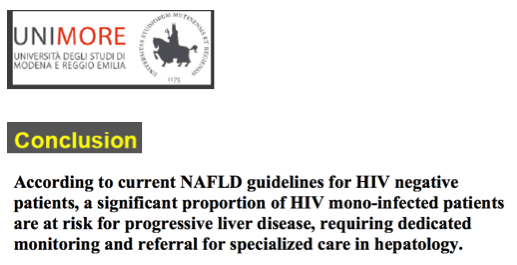
program abstract
Application of guidelines for fatty liver in two prospective cohorts
of human immunodeficiency virus positive patients
Sila Cocciolillo1, Andrea Malagoli2, Maria Osikowicz1, Tom Pembroke3, Marc Deschenes1, Maged Ghali1, Marina B. Klein1, Giovanni Guaraldi2, Giada Sebastiani1. 1Royal Victoria Hospital, McGill University Health Centre, Montreal, Canada; 2University of Modena and Reggio Emilia, Modena, Italy; 3School of Medicine, Cardiff University, Cardiff, United Kingdom
Background and aims: People living with Human Immunodeficiency Virus (HIV) are at higher risk of non-alcoholic fatty liver disease (NAFLD) than the general population. Recent guidelines from the European Association for the Study of the Liver recommend a diagnostic algorithm to identify HIV-negative NAFLD patients at risk of progressive liver disease. This stepwise algorithm is based on non-invasive screening for NAFLD, followed by fibrosis assessment by the biomarker FIB-4 and ALT. We aimed to apply this algorithm to HIV mono-infected patients.
Method: This was a cross-sectional analysis of two prospective screening programs for NAFLD in HIV-infected persons: the LIVEr disease in HIV (LIVEHIV) Cohort and the Modena HIV Metabolic Clinic (MHMC) Cohort. HIV-infected adults without significant alcohol intake or viral hepatitis coinfection were included. NAFLD was diagnosed in the LIVEHIV Cohort if controlled attenuation parameter (CAP) was ≥ 248 dB/m; and in the MHMC Cohort if liver/spleen HU ratio on abdominal CT was < 1.1. In both cohorts, significant liver fibrosis was defined as FIB-4 > 2.67. Patients with either elevated ALT or NAFLD with significant liver fibrosis were considered at risk for progressive liver disease requiring specialist referral for hepatology consultation. Logistic regression analysis was used to identify predictors of progressive liver disease.
Results: We included 1.228 mono-infected patients (mean age 50, 73% males, time since HIV diagnosis 16 years, CD4 634 cells/mm3; 30% with BMI > 25 kg/m2). Figure depicts the flowchart from the EASL guidelines applied to included patients. Overall, 31.8% had NAFLD and 25.2% were at risk of progressive liver disease.
Among patients without NAFLD, 18.4% had elevated ALT and were considered at risk of progressive liver disease. After adjusting for BMI, hypertension, CD4 cell count and exposure to protease inhibitors, male sex (aOR 1.57, 95% CI 1.08-2.28), diabetes (aOR 1.52, 95% CI 1.04-2.24) and duration of HIV infection (aOR 1.26, 95% CI 1.02-1.58) were independent predictors of risk of progressive liver disease requiring specialist referral, while Black ethnicity was protective (aOR 0.22, 95% CI 0.09-0.52).
Conclusion: According to current NAFLD guidelines for HIV negative patients, a significant proportion of HIV mono-infected patients is at risk of progressive liver disease, requiring dedicated monitoring and referral for specialized care in hepatology.
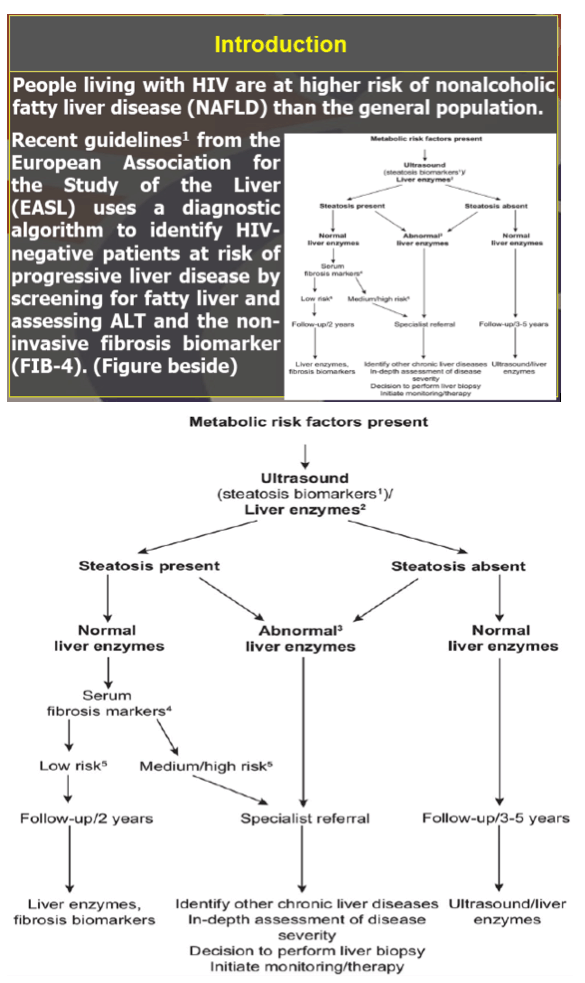
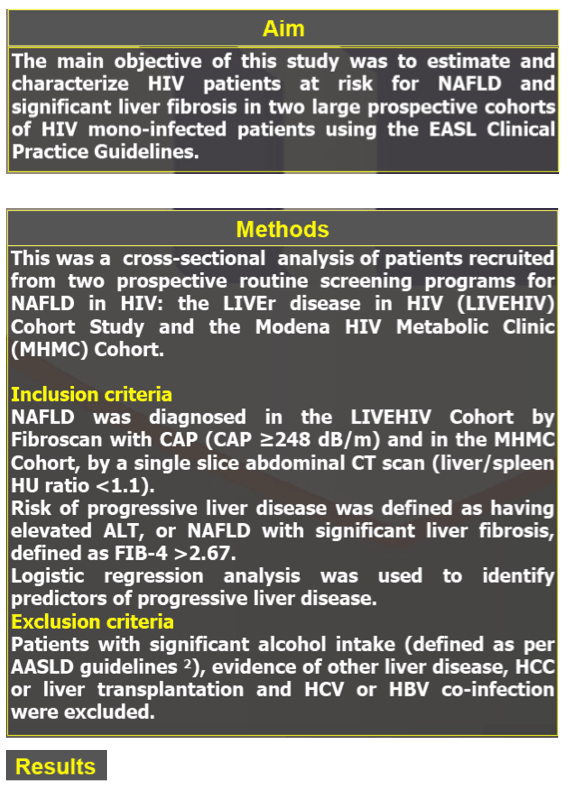
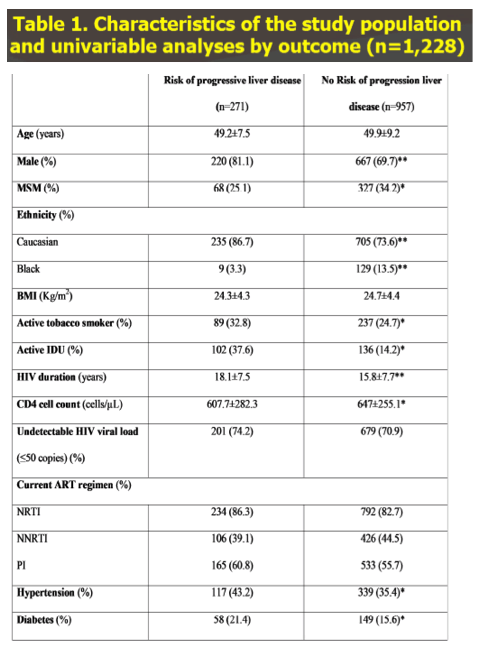
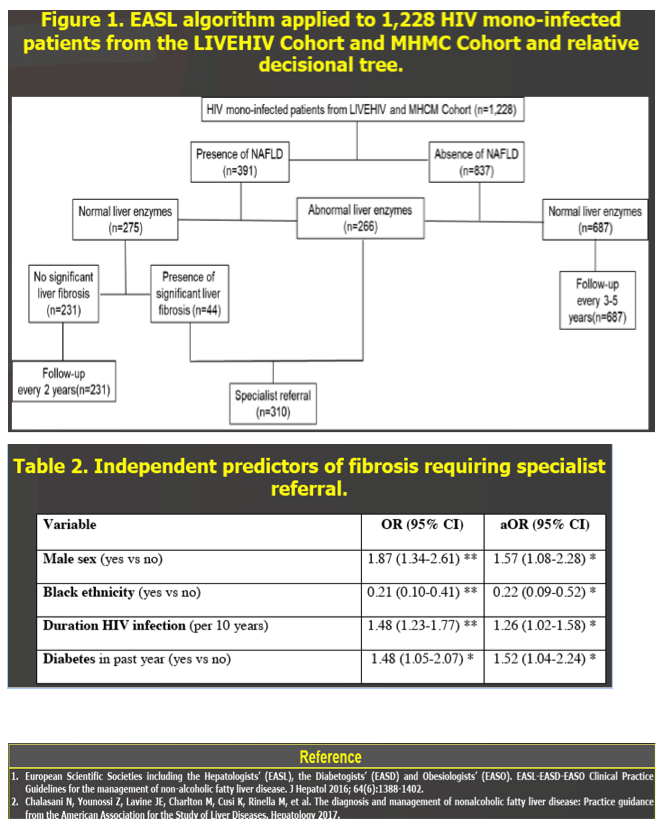
|
| |
|
 |
 |
|
|